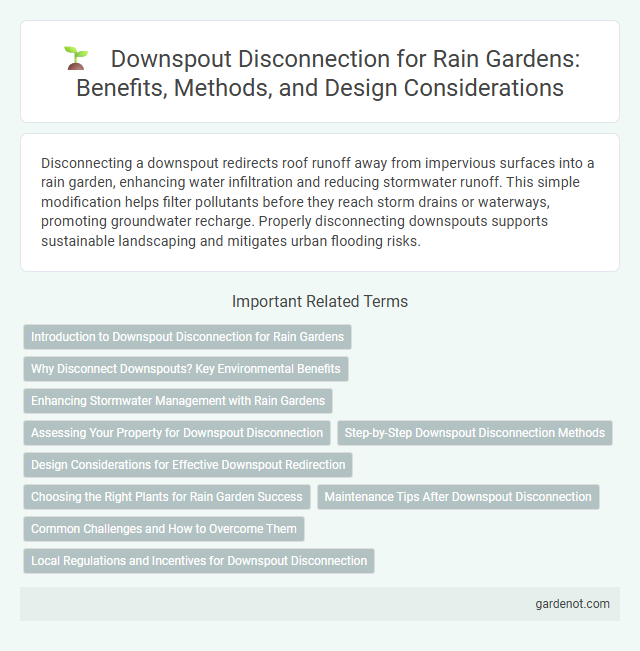Disconnecting a downspout redirects roof runoff away from impervious surfaces into a rain garden, enhancing water infiltration and reducing stormwater runoff. This simple modification helps filter pollutants before they reach storm drains or waterways, promoting groundwater recharge. Properly disconnecting downspouts supports sustainable landscaping and mitigates urban flooding risks.
Introduction to Downspout Disconnection for Rain Gardens
Downspout disconnection directs roof runoff away from storm drains into rain gardens, enhancing water absorption and reducing urban flooding. This method promotes groundwater recharge by allowing rainwater to infiltrate naturally, filtering pollutants before they reach waterways. Implementing downspout disconnection is a cost-effective stormwater management practice that supports sustainable urban drainage systems.
Why Disconnect Downspouts? Key Environmental Benefits
Disconnecting downspouts reduces the volume of stormwater directed into municipal sewer systems, alleviating flooding and decreasing the burden on wastewater treatment facilities. This practice promotes groundwater recharge by allowing rainwater to infiltrate soil through rain gardens, enhancing local aquifers and supporting plant health. It also minimizes pollutant runoff, preventing contaminants like oil, heavy metals, and fertilizers from entering natural water bodies.
Enhancing Stormwater Management with Rain Gardens
Disconnecting downspouts directs roof runoff away from impervious surfaces and into rain gardens, promoting natural infiltration and reducing stormwater volume. This practice decreases pollutant loads entering waterways by filtering contaminants through soil and vegetation. Integrating disconnected downspouts with rain gardens enhances urban stormwater management by mitigating flooding and replenishing groundwater supplies.
Assessing Your Property for Downspout Disconnection
Assessing your property for downspout disconnection involves evaluating the slope, soil type, and drainage patterns to ensure efficient water runoff into the rain garden. Identify downspouts that discharge near foundations or paved surfaces, increasing flood risk and water pollution, as prime candidates for disconnection. Proper site assessment maximizes rain garden benefits by directing clean stormwater, reducing erosion, and enhancing groundwater recharge.
Step-by-Step Downspout Disconnection Methods
Disconnecting a downspout from your gutter system involves carefully detaching the pipe using a screwdriver or wrench to remove screws or fasteners. After removal, extend the disconnected downspout outlet into a rain garden area by installing a flexible downspout extender or directing water flow with an elbow pipe. Ensure proper grading and mulch placement around the rain garden to maximize infiltration and prevent erosion.
Design Considerations for Effective Downspout Redirection
Effective downspout redirection in rain garden design requires ensuring the discharge point is at least 10 feet away from building foundations to prevent water damage. The slope between the downspout and the rain garden must be gentle, ideally around 2%, to facilitate smooth water flow without causing erosion. Incorporating splash blocks or gravel trenches at the redirection point minimizes soil displacement and enhances infiltration efficiency.
Choosing the Right Plants for Rain Garden Success
Selecting native, water-tolerant plants such as switchgrass, blue flag iris, and red twig dogwood ensures effective water absorption and soil stabilization in a disconnect downspout rain garden. These species thrive in both wet and dry conditions, reducing maintenance needs and promoting local biodiversity. Proper plant selection maximizes rainwater infiltration, mitigates runoff, and enhances the garden's ecological function.
Maintenance Tips After Downspout Disconnection
After disconnecting a downspout from a rain garden, regularly inspect the flow path to prevent erosion and ensure water disperses evenly across the garden bed. Clear debris such as leaves and sediment from both the rain garden and the downspout extension to maintain proper drainage and avoid clogs. Monitor plant health frequently, adjusting irrigation as needed to support native species adapted to fluctuating moisture levels in rain garden ecosystems.
Common Challenges and How to Overcome Them
Disconnecting downspouts to direct water into rain gardens often faces challenges such as improper grading, clogged pipes, and insufficient overflow paths. Ensuring a proper slope away from the foundation, regular maintenance to clear debris, and installing an overflow system can effectively mitigate flooding and water damage. Utilizing permeable materials around the downspout connection enhances infiltration and prevents erosion.
Local Regulations and Incentives for Downspout Disconnection
Local regulations often mandate downspout disconnection to reduce stormwater runoff and prevent sewer overflows, especially in urban areas. Many municipalities offer incentives such as rebates, grants, or technical assistance for installing rain gardens or disconnecting downspouts to promote sustainable water management. Compliance with these regulations not only minimizes flooding risks but also enhances groundwater recharge and supports environmental conservation efforts.
Disconnect downspout Infographic

 gardenot.com
gardenot.com